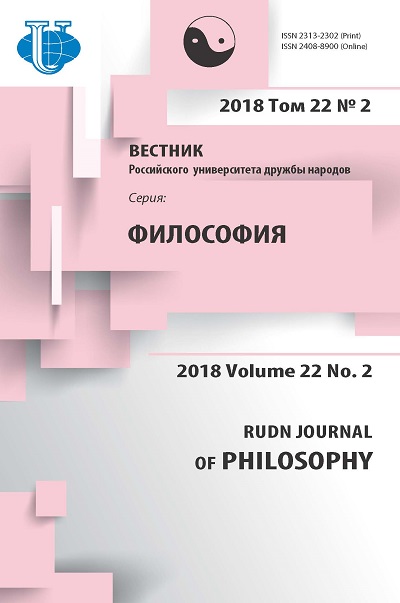Language, brain and computation: from semiotic asymmetry to recursive rules
- Authors: Baryshnikov PN1
-
Affiliations:
- Pyatigorsk State University
- Issue: Vol 22, No 2 (2018)
- Pages: 168-182
- Section: Ontology and epistemology
- URL: https://journals.rudn.ru/philosophy/article/view/18712
- DOI: https://doi.org/10.22363/2313-2302-2018-22-2-168-182
- ID: 18712
Cite item
Full Text
Abstract
This article reviews the comparative analysis of the most promising theoretical areas exploring the correlation principles of the structural / functional brain organization and cognitive characteristics of the language. A special role in the presented approaches is assigned to the principles of computability. The article discusses the advantages and disadvantages of the modular and holistic models in the context of semiotic asymmetry. It is important to emphasize that the language model as a set of hierarchically represented objects is consistent with only with the connectivism paradigm (brain as a network), in which the main element is the functional neuron, and it is not the biological neuron but its simplified information model. The informational simplification creates a number of contradictions. We have analyzed the methodological basis of neural network approach and principles of recursive organization. The main question is, do neuron structures determine the principles of mental representations and computational grammar models? The uniformity of syntax and logical structure of neurons creates metaphorical and a not completely correct hypothesis that brain is a network of functional units that computes grammar and syntax rules. One of the objectives of this work is to identify the methodological inconsistencies arising from the computational models of language structures and language activity.
About the authors
P N Baryshnikov
Pyatigorsk State University
Author for correspondence.
Email: pnbaryshnikov@pglu.ru
- Kalinina str., 9, Pyatigorsk, Russia 357500
References
- Arbib, Michael A. 2010. Action to language via the mirror neuron system. Cambridge: Cambridge University Press.
- Arbib, Michael A., and G. Rizzolatti. 1998. Language within our grasp. Trends in Neuroscience 21: 188-194.
- Barulin, Anatoliy N. 2013. How it happened with you, Adam? Discussion about origin of language. Antropologicheskij forum 19: 300-326.
- Chafe, Wallace. 2008. The role of introspection, observation and experimentation in the interpretation of thought. In Computers, brain, cognition: success of the cognitive sciences, ed. BM. Velichkovskij and V Soloviyov, 163-178. Moscow: Nauka.
- Chernigovskaya, Tatiana V. 2004. Brain and language: a century and a half of investigation. In Teoreticheskie problemy jazykoznanija: Sb. st. k 140-letiju kaf. obshhego jazykoznanija SPbGU, ed. L.A. Verbickaja, 16-28. Saint Petersburg: Filol. fak-t SPbGU.
- Corballis, Michael C. 2011. The recursive mind. The origins of human language, thought, and civilization / Michael C. Corballis. Princeton, N.J., Woodstock: Princeton University Press.
- Deglin, Vadim L. 1996. Lectures about functional asymmetry of human brain. Amsterdam-Kiev.
- Dijk, Teun Adrianus van. 1981. Studies in the pragmatics of discourse. The Hague, New York: Mouton.
- Everett, Daniel. 2005. Cultural constraints on grammar and cognition in Piraha. Current Anthropology 46 (4): 621-646.
- Gentner, Timothy Q., Kimberly M. Fenn, Daniel Margoliash, and Howard C. Nusbaum. 2006. Recursive syntactic pattern learning by songbirds. Nature 440 (7088): 1204-1207.
- Hauser, Marc D., Noam Chomsky, and W. Tecumseh Fitch. 2002. The faculty of language: what is it, who has it, and how did it evolve? Science (New York, N.Y.) 298 (5598): 1569-1579. doi: 10.1126/science.298.5598.1569.
- Hickok, Gregory. 1993. Parallel Parsing: Evidence from Reactivation in Garden-Path Sentences. Journal of Psycholinguistic Research Journal of Psycholinguistic Research 22 (2): 239-250.
- Hofstadter, Douglas R. 1979. Gödel, Escher, Bach. An eternal golden braid. New York: Basic Books.
- Hulst, Harry van der. 2010. Re Recursion. In Recursion and human language, ed. Hulst, Harry van der, 15-53. Studies in generative grammar, vol. 104. Berlin, New York: De Gruyter Mouton.
- Isakadze, Natalia V. 1998. Reflection of morphology and nominal group referential semantics in the formal syntax. (Thesis) Diss.. kand. nauk. MGU im. Lomonosova, Moscow.
- Jackendoff, Ray, and Steven Pinker. 2005. The nature of the language faculty and its implications for evolution of language (Reply to Fitch, Hauser, and Chomsky). Cognition 97 (2): 211-225. doi: 10.1016/j.cognition.2005.04.006.
- Jackson, John H. 1874. On the nature of the duality of the brain. Medical Press and Circular (1).
- Jacobson, Roman. 1985. The linguistic types of aphasia. In Selected works, ed. Zvegincev V.A., 287-301. Moscow: Progress.
- Kibrik, Аlexander E. 2008. Cognitive approach to language. In Computers, brain, cognition: success of the cognitive sciences, ed. B.M. Velichkovskij and V. Soloviyov, 202-230. Moscow: Nauka.
- Krotkova, Olga A., and Boris M. Velichkovskij. 2008. Interhemispheric differences of thought under the lesion the higher gnostic areas of the brain. In Computers, brain, cognition: success of the cognitive sciences, ed. B. M. Velichkovskij and V. Soloviyov, 107-132. Moscow: Nauka.
- Lamb, Sydney M. 1999. Pathways of the brain. The neurocognitive basis of language. Amsterdam studies in the theory and history of linguistic science. Series IV, Current issues in linguistic theory, v. 170. Amsterdam, Philadelphia: J. Benjamins.
- Lamb, Sydney M. 2008. What data types are used in neurocognitive linguistics. In Computers, brain, cognition: success of the cognitive sciences, ed. B. M. Velichkovskij and V. Soloviyov, 180-201. Moscow: Nauka.
- Lotman, Yuri M. 1993. Brain-text-culture-artificial intelligence. In Selected works in 3 vol., vol. 1, 25-33. Tallinn: Alexandra.
- Luria Alexander R., and James V. Wertsch. 1981. Language and cognition. Washington, D.C., New York: V.H. Winston; J. Wiley.
- Panov, Evgueniy N. 2012. Paradox of continuity. Language Rubicon: on impassable gulf between the animal signal systems and the human language. Moscow: Jazyki slavjanskih kul'tur.
- Pinker, Steven. 2004. The language instinct. Moscow: Editorial URSS.
- Ramachandran, Vilayanur S. 2006. Broken mirrors a theory of autism. Scientific American 295 (5): 62-69.
- Rizzolatti, Giacomo, Corrado Sinigaglia, and Frances Anderson. 2008. Mirrors in the brain. How our minds share actions, emotions, and experience. Oxford: Oxford University Press.
- Schiffman, Harvey Richard. 2000. Sensation and perception. An integrated approach, 5th edn. New York: Wiley.
Supplementary files















